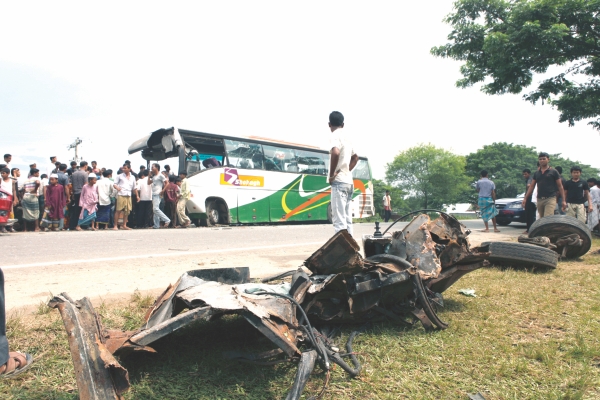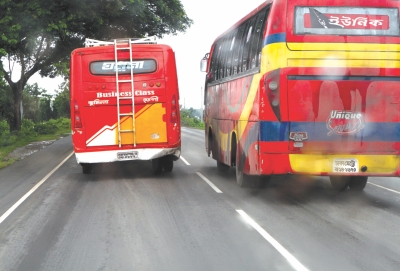| Home - Back Issues - The Team - Contact Us |
 |
| Volume 10 |Issue 30 | August 05, 2011 | |
|
|
City
Living in a Death Trap Anika Hossain It is quite obvious, that the traffic situation in Dhaka is out of control. There is a noticeable increase in the number of vehicles on the roads but no visible signs of the authorities trying to improve the situation, say by improving the condition of the roads, and implementing traffic rules and regulations. But being stuck in a gridlock on the roads every day seems harmless compared to the tragic consequences caused by the lack of traffic control-road accidents. Not a day goes by when there isn't a gruesome vehicular accident splashed all over the headlines, a large number of these being fatal. Just recently, 40 school children died in a horrible accident in Misarai because the driver was distracted by a conversation on his cell phone- a direct violation of traffic rules. Dr Hasib Mohammad Ahsan, the Director of the Accident Research Institute (ARI) says “Accidents happen because of many reasons, the first of which is, the roads in our country are not maintained properly as per the safety standards set by the laws. Vehicles are often defective or overloaded and the roads are not built to bear this weight. Also, drivers are irresponsible and do not abide by the traffic rules. In my opinion, the pedestrians are equally irresponsible and cross roads recklessly.” According to Ahsan, this irresponsibility comes from the lack of awareness about the basic rules. “Most people cannot recognise road signs and traffic signals,” he says “Last year, 54 percent of people who died in accidents were pedestrians."
The National Legislation has set many traffic regulations. The Motor Vehicle Ordinance of 1983 states that the maximum speed limit for light vehicles such as cars and motorcycles is 113 kilometres per hour (kmph), for buses and minibuses it is set at 56 kmph, for trucks it is 40kmph and for fire trucks 48kmph.Of course speed limits vary according to zones such as in front of schools and hospitals or in residential areas. Unfortunately, very few people abide by the speed limit, especially drivers of heavy vehicles such as trucks and buses. “We try to enforce traffic rules as much as possible,” says a traffic police who requested anonymity. “But we need more manpower to do so. There is so much traffic violation nowadays it is difficult to keep our eyes on everyone. There are also some corrupt law enforcement officers who accept bribes to let the offenders go.” According to him, there are also a limited number of highway speed detectors, possibly less than forty, to monitor the speed of vehicles all over the country. The legislation also includes safety regulation for all passengers. It is mandatory for all occupants in a vehicle to wear seat-belts and have child restraints and if on a motorcycle, to wear helmets. There are also laws restricting the number of passengers on different types of vehicles (not more than four persons is allowed in a four seater). The use of cell phones during driving has also been barred. Following the vehicle in front too closely is also against the law, as is not maintaining lanes while driving. Drinking and driving is strictly prohibited. There are now check posts set up by law enforcement officers from the police force, army and rapid action battalion (RAB) who can stop vehicles at random to perform breath tests etc. Violation of any of these laws will result in the offender having to pay heavy fines. Unfortunately, none of these laws are properly implemented. Corruption within the law enforcement system causes officers to turn a blind eye to many violators of traffic rules. Corruption also lies within the Bangladesh Road Transport Authority (BRTA) where certain officials accept bribes to issue licenses to incompetent drivers who have failed their driving tests. “I took the driving test twice and did not pass the written exam,” says Nuruzzaman, who has been a driver of a private vehicle for ten years now. “Then an acquaintance of mine told me if I collected some money and gave it to him, he knew an official at the BRTA who could help me get a license without taking the test.” There are many such drivers with false licenses operating vehicles on our roads. Sometimes, truck and bus drivers train their young helpers inadequately, to take over the wheel often causing grievous, fatal accidents. “I don't wear my seat belt until I see a check post or am about to be stopped by a Sergeant,” says Bashar Amin, who is employed as a driver by a local factory. “I also talk on my mobile phone. Why shouldn't I? My job requires me to speak to people when I am on the road. The police don't say anything, even if they see what I'm doing.” The Ministry of Communications has imposed a ban on operating 20-year-old public vehicles such as buses and minibuses in Dhaka. Unfortunately, corrupt officials in the BRTA are making crores by issuing fake registration numbers and documents for old, potentially dangerous vehicles. These old vehicles are given a makeover with fresh paint and new tires to make them look as good as new. The pedestrians, who are usually the victims of road accidents, have no choice but to walk on the roads. “There is no space on the sidewalks for us,” says pedestrian Rumana Hossain who walks to work everyday. “They are packed with vendors and garbage and smell of urine. There aren't enough footbridges in this city and those that are there, are extremely unsafe at night. I was robbed a few times on foot bridges.” According to Ahsan, the Director of ARI, the needs of pedestrians are grossly neglected. “They need space to walk and safe zones to cross roads,” he says. "More speed breakers and wide zebra crossings need to be placed in front of schools, colleges and hospitals," says Momena Khan, a mother of a school-going child. There are perhaps thousands of accidents happening on our roads each year, but most go unreported. Among the reported accidents, statistics show that there has been a significant rise over the past few years. According to BRTA statistics, there were a total of three thousand five hundred and thirty one reported accidents in the year 2008 among these; two thousand seven hundred and twenty three were fatal. There were 500 accidents at the beginning of 2010 and several notably violent ones since, taking the lives of many. Prevention techniques need to be developed immediately. Traffic laws need to be strictly implemented and harsh punishments issued to those who break them. The authorities also need to improve their post accident aid resources such as proper ambulances, trained paramedics and equipment that can reduce the number of fatalities. Until these changes and improvements are made, we are all living in one giant death trap.
Copyright
(R) thedailystar.net 2011 |

